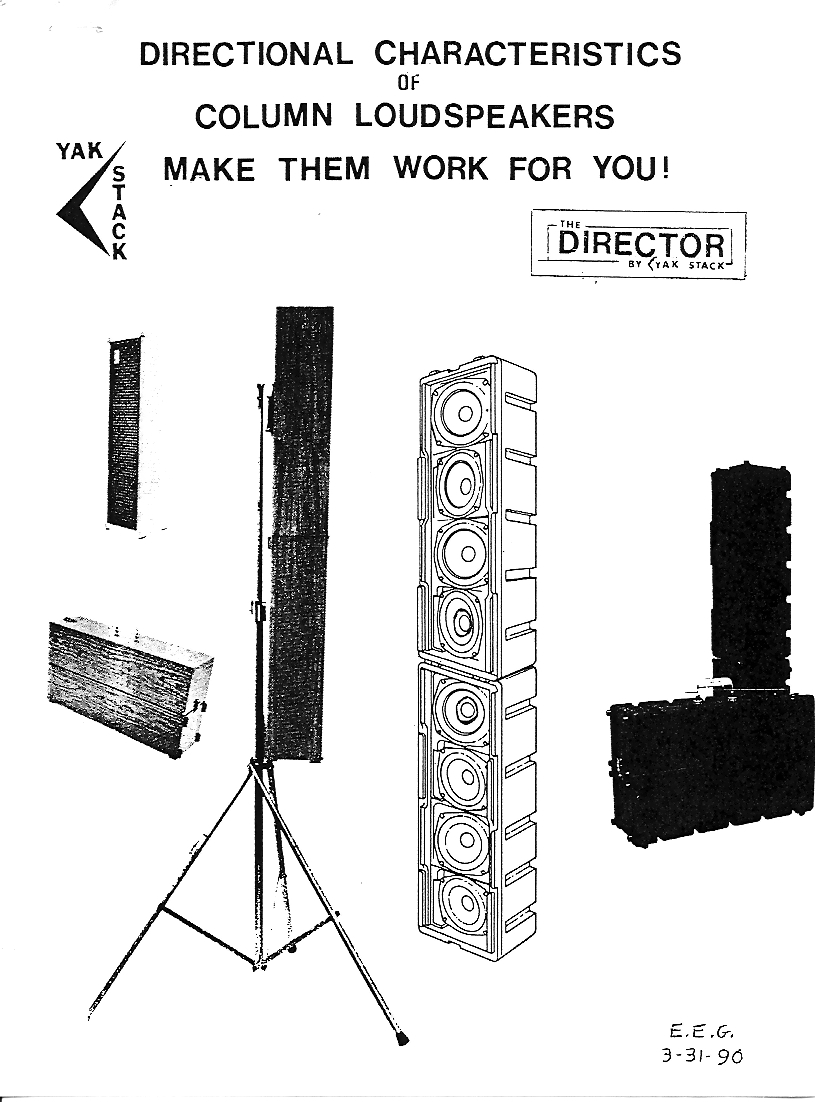

A brief description of the useful characteristics of a sound column will be presented here and the successful application of these characteristics will be described.
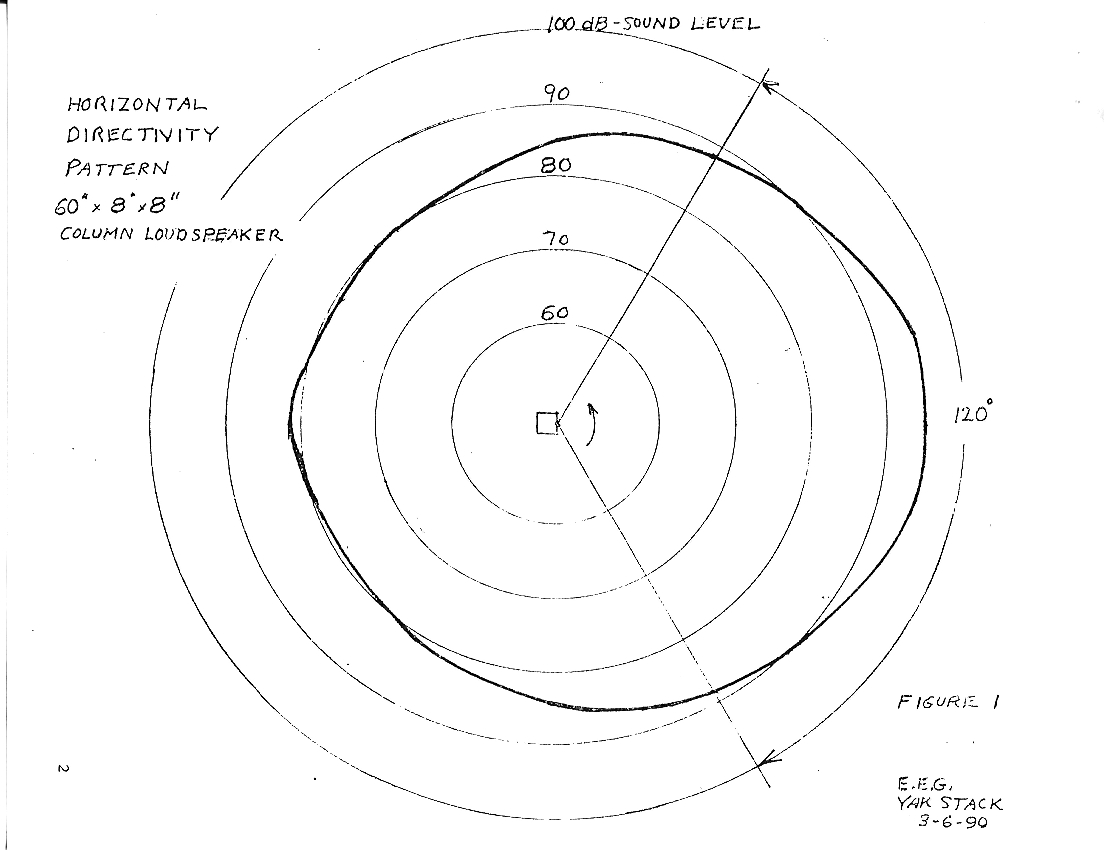 This is a "polar" plot
made in a free-field or
"anechoic"
room
... that is, a room designed to look to sound as though there were no
walls, ceiling, or floor. (No sound reflections, no echoes.)
This is a "polar" plot
made in a free-field or
"anechoic"
room
... that is, a room designed to look to sound as though there were no
walls, ceiling, or floor. (No sound reflections, no echoes.)
A constant signal is fed to the loudspeaker and its sound output is measured with a microphone in a fixed position as the loudspeaker is rotated around its vertical axis. The angular rating 120° is determined by the two points where the output sound level drops 2 to 1 or 6 dB. In Figure 1 we see that the output level of this column loudspeaker remains in this 6 dB range over the horizontal angle of 120°.
Another way to make the measurement (still in an "anechoic" space) is to mount the loudspeaker in a fixed position and move the microphone, at a fixed distance, around the speaker's vertical axis.
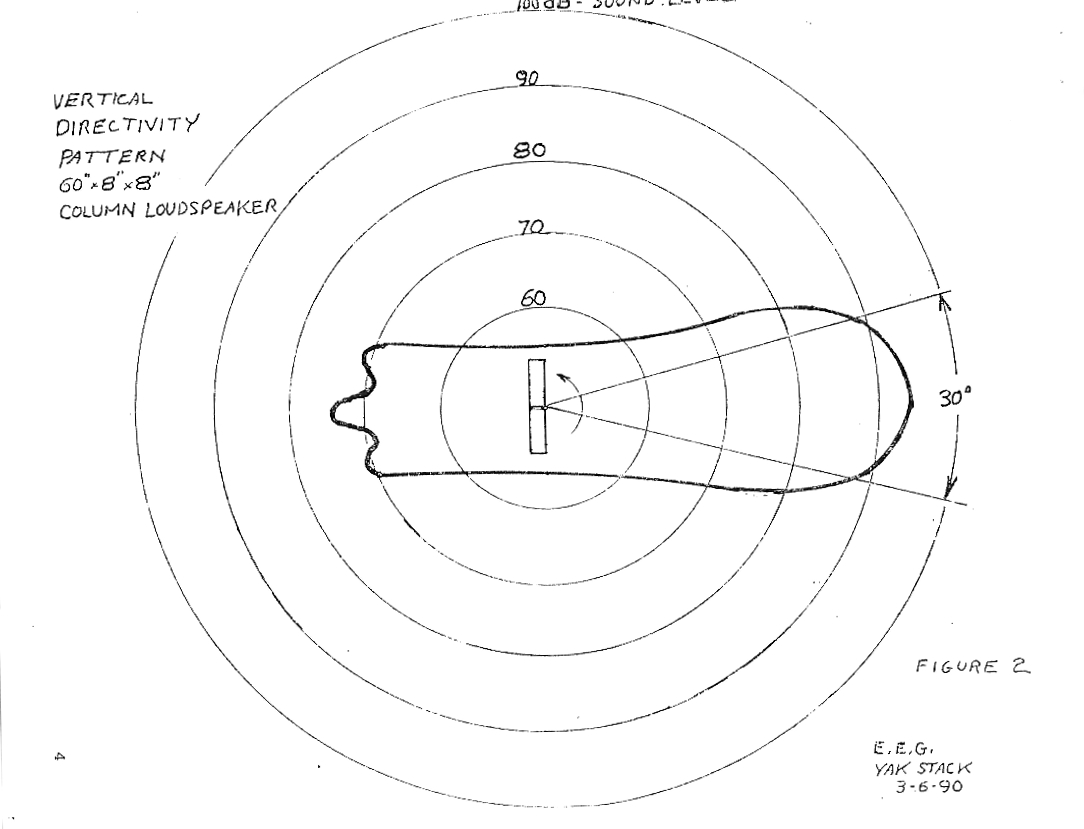 This is another polar plot made in an anechoic space. Here, again, the
microphone is held in a fixed position but the loudspeaker is rotated about
its horizontal axis. This is not easy to do with a tall column loudspeaker. A
turntable to do this for a 5' tall loudspeaker must be much stronger and
heavier than one needed for the horizontal plot.
This is another polar plot made in an anechoic space. Here, again, the
microphone is held in a fixed position but the loudspeaker is rotated about
its horizontal axis. This is not easy to do with a tall column loudspeaker. A
turntable to do this for a 5' tall loudspeaker must be much stronger and
heavier than one needed for the horizontal plot.
The angular rating is determined in the same way as the horizontal, the speaker rotation through which the output of the column stays within 6 dB of the maximum output. In this case, we see that the vertical pattern is 30° wide.
Both the horizontal pattern and the vertical pattern are the same for a 15"-diameter conventional loudspeaker. They would be very similar to Figure 1 but would probably be about 110° horizontal and 110° vertical.
Figure 1 and 2 were obtained for a column array 8" wide x 8" deep x 60" high. For a 6"-wide column we would expect the horizontal pattern to be wider or approximately 135°. For a column 90" high we would expect the vertical pattern to be narrower or approximately 25°. For a shorter column, say 45" high, the vertical pattern would be expected to be approximately 40°.
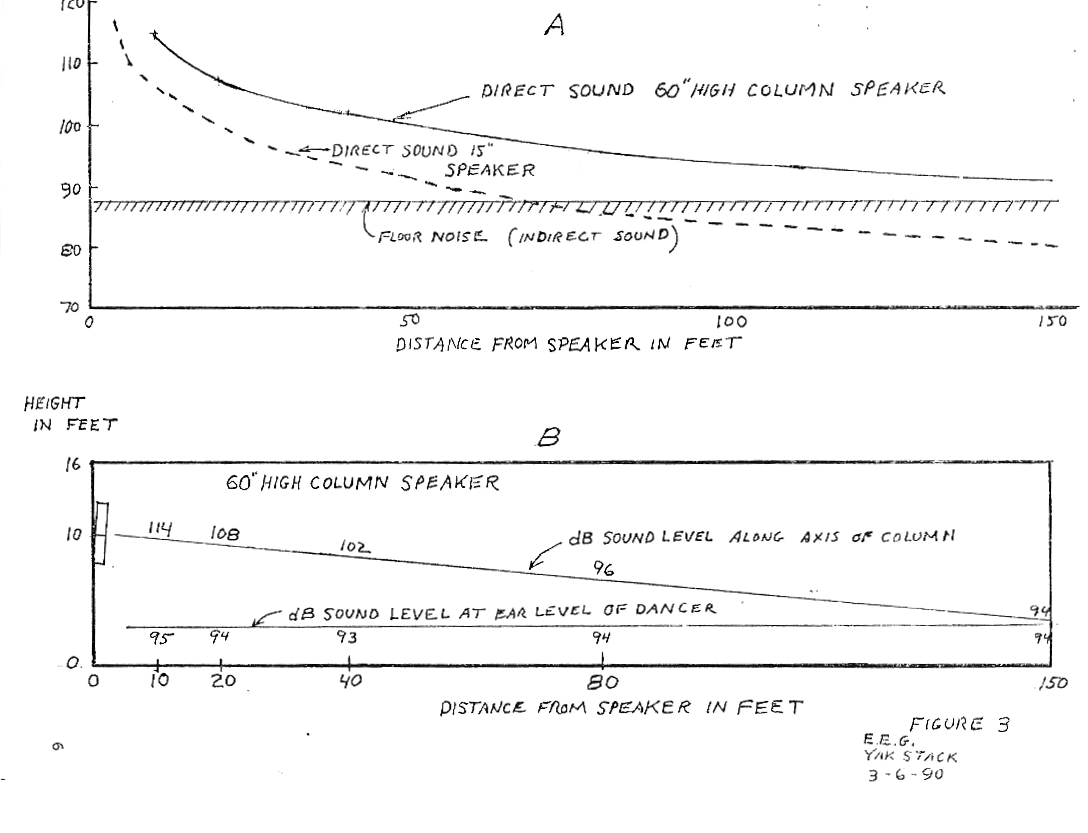 The sound level produced by a conventional loudspeaker, a column loudspeaker,
or any sound source decreases at the rate of 6 dB or 2 to 1 every time you
double the distance from the sound source. As usual, such a measurement is
made under free-field (anechoic) conditions.
The sound level produced by a conventional loudspeaker, a column loudspeaker,
or any sound source decreases at the rate of 6 dB or 2 to 1 every time you
double the distance from the sound source. As usual, such a measurement is
made under free-field (anechoic) conditions.
Normally, for test purposes, the output of a conventional loudspeaker is measured at a distance equal to at least two times the major dimension of the speaker. Distances of 3' or 1 meter are commonly used. These distances do not apply for a column loudspeaker. Here, the distance should be at least two times the height of the column. If one measures closer than this, all of the individual speakers in the column will not contribute properly to the measurement. A measurement distance of 10' is indicated for a 60"-tall column. This is an unsuspected advantage of the column loudspeaker. The point at which sound starts to decrease 2 to 1 (6 dB) for each doubling of the distance is 10' for the 60" column versus 3' for the 15" loudspeaker. Hence, you can get useful sound at much greater distances with the column.
Figure 3A shows useful direct sound from the column loudspeaker (well above background and reflected sound) to distances beyond 150' while direct sound from the conventional loudspeaker drops below the background level beyond 70'.
Another feature of the column loudspeaker is illustrated in Figure 3B . By mounting the column with its centerline 10' above the floor and tilting at about 5°, the sound level at the ear level of a listener (a dancer, for example) is maintained at 93-95 dB while the sound level along the axis of the column drops from 114 to 94 dB. The 5° tilt also helps to avoid undesirable echoes off the rear wall. (These echoes may not be noticed by the listener in the hall, but they can become very obvious and annoying to the performer on stage.)
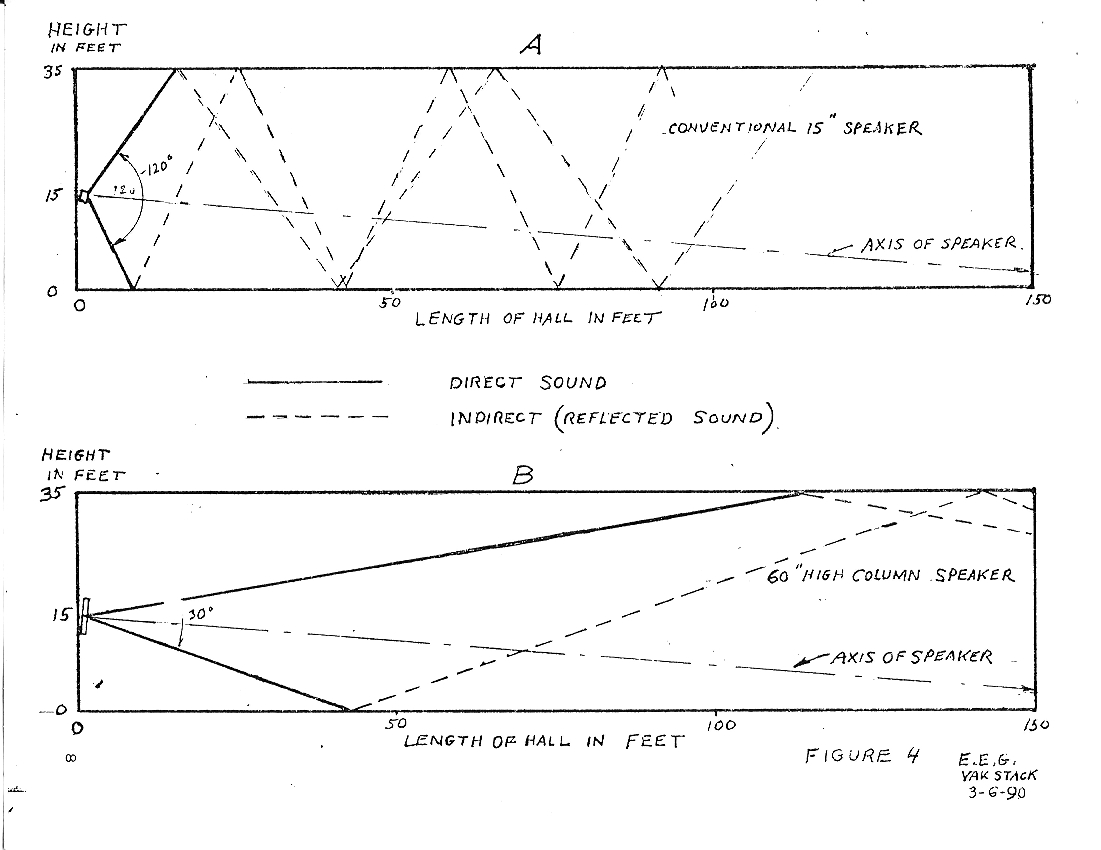 Figure
4
illustrates, in another way, the benefit of a column loudspeaker array.
Ideally, we would like to think that all the sound from the loudspeaker used
to reinforce speech and music gets directly to the listener. In
Figure
4A
, we see that when we use a conventional loudspeaker, even in a hall
with a high (35') ceiling, a large portion of the sound is reflected sound
beyond 40' into the hall. This is why many P.A. systems sound muddied and
speech becomes unintelligible.
Figure
4
illustrates, in another way, the benefit of a column loudspeaker array.
Ideally, we would like to think that all the sound from the loudspeaker used
to reinforce speech and music gets directly to the listener. In
Figure
4A
, we see that when we use a conventional loudspeaker, even in a hall
with a high (35') ceiling, a large portion of the sound is reflected sound
beyond 40' into the hall. This is why many P.A. systems sound muddied and
speech becomes unintelligible.
Figure 4B shows the same hall using a 60"-high column loudspeaker for sound reinforcement. It is clear that the reflected sound contributes much less in Figure 4B than in Figure 4A.
Having discussed several characteristics of conventional loudspeakers and column loudspeakers, it appears that in each case the performance of the column loudspeaker was superior to that of the conventional loudspeaker. Horizontal and vertical directivity patterns determined by physical dimensions of the column array of loudspeakers make it possible to mount and aim the column to achieve excellent coverage of a hall by avoiding echoes and keeping the direct sound the dominant signal to reach the listener.
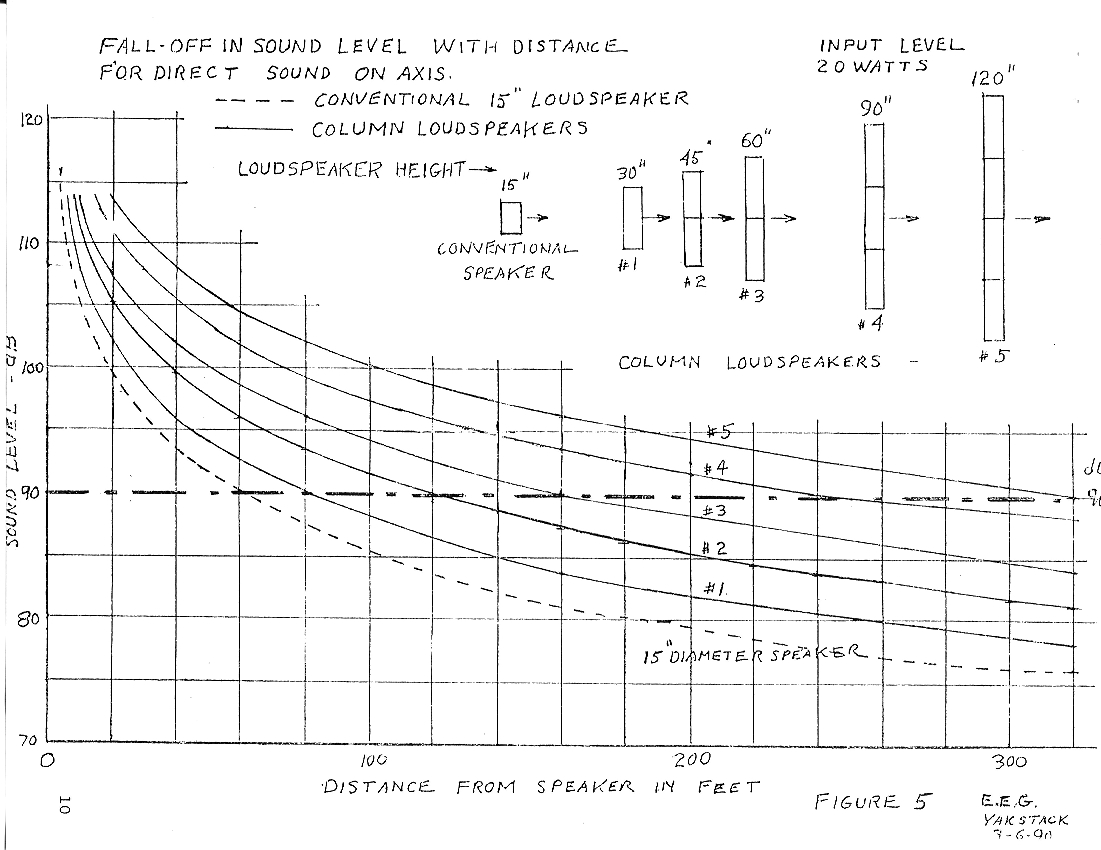 Use
Figure
5
to determine, at the planning stage, the height (length) of a column
required to cover a hall of known dimensions. The curves in
Figure
5
are a series of curves showing the fall-off in sound level as one moves
away from the loudspeaker. The dashed curve is for a conventional 15" diameter
loudspeaker. The solid curves #1 thru #5 are for column loudspeakers of
various heights. At the 90 dB sound level, a heavy dot-dash line is drawn to
indicate an acceptable sound level for sound reinforcement.
Use
Figure
5
to determine, at the planning stage, the height (length) of a column
required to cover a hall of known dimensions. The curves in
Figure
5
are a series of curves showing the fall-off in sound level as one moves
away from the loudspeaker. The dashed curve is for a conventional 15" diameter
loudspeaker. The solid curves #1 thru #5 are for column loudspeakers of
various heights. At the 90 dB sound level, a heavy dot-dash line is drawn to
indicate an acceptable sound level for sound reinforcement.
If you check where the dashed curve intersects the heavy dot-dash line, you will find that a conventional 15"-diameter loudspeaker can be expected to run into trouble beyond 60-80'. If you check where solid curve #3 intersects the heavy dot-dash line, you will find that a 60"-high column loudspeaker should be good out to 160-200'. You will also note that solid curve #5 runs 6 dB (2 to 1 in sound level or 4 to 1 in power level) above curve #3 and that a l20"-high column should project out to 320 plus feet. To get the same sound level using a 60"-high column, you would have to drive it with 80 watts instead of 20 watts. Is it less expensive and less trouble to use a 20-watt amplifier and a l20"-high column (2 60"-high columns one above the other would do) or an 80 watt amplifier and a 60"-high column.
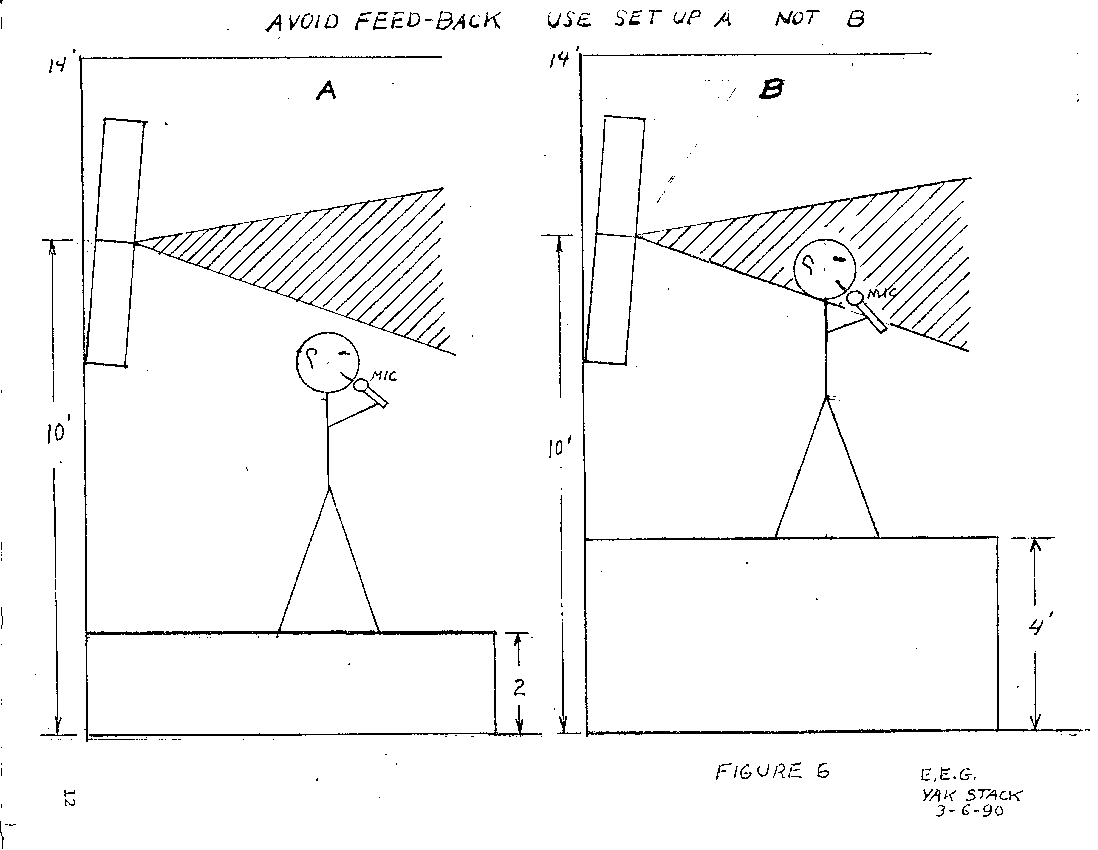 Another control you have with the column loudspeaker is that over acoustic
feedback (loudspeaker to microphone). This is very important in some
situations when you are trying to get the desired amplified signal level
comfortably above an annoying but uncontrolled background noise.
Figure
6A
illustrates a comfortable situation achieved in a low-ceilinged hall by
knowing the vertical pattern of your column loudspeaker. If the desire to make
your performer prominent caused you to increase the height of the stage, you
may find yourself in the uncomfortable position illustrated by
Figure
6B
.
Another control you have with the column loudspeaker is that over acoustic
feedback (loudspeaker to microphone). This is very important in some
situations when you are trying to get the desired amplified signal level
comfortably above an annoying but uncontrolled background noise.
Figure
6A
illustrates a comfortable situation achieved in a low-ceilinged hall by
knowing the vertical pattern of your column loudspeaker. If the desire to make
your performer prominent caused you to increase the height of the stage, you
may find yourself in the uncomfortable position illustrated by
Figure
6B
.